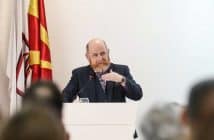The roadmap for one of the State’s largest capital programmes was unveiled today, Friday September 27th 2013, with the publishing of the Limerick Regeneration Framework Implementation Plan.
The 500 page document, which was launched at Thomond Park, is the first time the Limerick Regeneration programme has a clear and deliverable plan. It is focussed on the three key pillars – Economic, Physical and Social – of the programme that will revitalise the communities over the next ten years by raising standards of living, opportunity and health and wellbeing for all residents of the regeneration areas.
The Framework Implementation Plan has been drawn up over a 12 month period and is very much evidence based, drawing from the previous four years of analysis and research on the ground across the regeneration areas.
The Framework Implementation anticipates an average of €28m per annum invested over the term of this Government and beyond, with the funding drawn from the exchequer, European funding, the voluntary housing sector and the private sector. The plan will also dovetail with the Limerick 2030 Economic Plan designed to revitalise the city and countywide economy.
Announcing the programme, Minister Jan O’Sullivan said: “Today is a landmark day for all the citizens of Limerick. The clear message to go out today is that the Government is firmly committed to the successful regeneration of Limerick. We are giving regeneration a new impetus, a new focus and look forward to the acceleration of the construction projects throughout the city.
“This substantial investment will revive communities. It will also provide a major boost in construction employment. It is a matter of particular pride to me that local people will have access to new job opportunities created by regeneration. Social employment clauses in contracts will ensure that the skills of local people are deployed as we ramp up the regeneration of Limerick.
“This is an exciting time for Limerick. I believe there is a real spirit of optimism in the city. This is not to dismiss the major problems that exist. However, I do believe that together we have the resolve to overcome these challenges and achieve the potential that we know exists in our communities.”
Limerick City and County Manager Conn Murray said that after a challenging start for the project, not least due to the economic decline, the overall Regeneration programme now has a practical and deliverable framework.
“A key strength of what is being set out today is that the plan is evidence-based. Our Office of Regeneration staff have listened to the communities, taken on board their needs and this plan is very much framed on that feedback. The consultation will continue with a six week period for final submissions.
“Naturally, funding will be key to the project’s success and we very much welcome the commitment from Minister Jan O’Sullivan, Finance Minister Michael Noonan and the wider Government to this plan. We are also very reassured by the Minister’s establishment of a cross-departmental Programme Delivery Group which will act as a forum to ensure any hurdles to projects can be released. At our end we will be constantly monitoring progress and carrying out formal annual reviews to ensure deliverability and efficiencies.”
While the largest spend will be on Physical Regeneration projects over the next ten years with €253m, each of the three pillars are mutually dependent. Some €30m will be spent on Social Regeneration projects, which has been already significantly funded over the past five years, and a further €10m on Economic Regeneration.
Physical regeneration, which is already underway with a number of cross-city developments, will involve a range of projects from new housing construction to renewal/retrofitting of housing, social and educational projects as well as road network infrastructure.
Design will be a key element to all physical regeneration projects to ensure that it facilitates a greater sense of community. The programme of new build, rebuild and refurbishment will also be subject to the adoption of social clauses to enhance the prospects of local employment and training during the physical regeneration process.
The single largest spend in the overall Implementation Plan will be €40m on the Coonagh-Knockalisheen Distributor Road.
In the Southill and Ballinacurra Weston areas some €16m will be spent on the refurbishment of public and private houses.. There will be an investment of €15m on elderly and conventional housing at Lord Edward Street.
In the St. Mary’s regeneration area €9m will be invested in the refurbishment of houses and €7m on replacement houses. A further €10m will be spent on a range of access roads and associated infrastructure at the same location. St. Mary’s Park will also receive a €2.5m community centre.
In addition to the Coonagh-Knockalisheen Distributor Road, the Moyross area will see €37m on replacement housing, €10m on refurbishment, with €7.8m on strategic demolition, €2.5m on the Northside Regional Park, €2.5m on upgrading the Moyross Community Enterprise Centre, €2m on strategic site purchases and €2m on the Moyross Avenue upgrade.
Social Regeneration will involve an average annual investment of €3m. Its overall focus will be on improving the quality of life of residents in the regeneration communities, improving health and well-being of the population, closing gaps in health with the average population, improving the social environment and safety on the estates, stabilising community life and supporting civic engagement in the community.
It will also seek to address needs of the population so that they can access opportunities, and close gaps in standards of living. This covers improved access to economic and social opportunities linked to preventive interventions in early years, interventions to improve attainment in education from the earliest stages and access to further education, training and work.
It will also seek to influence and improve the coherence of service provision across the statutory and voluntary/community sector, with a view to improving effectiveness in responding to needs of the population and to achieve better value for money invested by the totality of the services.
One of the most dynamic projects of the overall programme will be the development of the National Social Innovation Hub to facilitate the development of social entrepreneurship and stimulate local enterprise development, create employment opportunities and act as a focal point for capacity building and job creation. This will be the first such centre of its kind in Ireland and will be designed to attract the support and patronage of Multi National Companies (MNC) widely engaged in social innovation and will work closely also with the recently announced Limerick Economic Innovation Hub as well as third level institutes.
The Economic programme will see €1m per annum invested in areas such as training, work experience/work placement and job creation. Niche economic activities will focus on growth sectors such as green technologies as well as developing a “knowledge – economy” sub-sector in community development and community enterprise.
The economic development strategy for regeneration is focused on the delivery of a number of key objectives. They include ensuring the growth of local capacity through the provision of focused sectoral training and employment opportunities, development of a stronger engagement platform to promote economic activity in the target areas between all stakeholder groups and local resources.
It will also seek to foster a culture of social innovation and social enterprise in the Regeneration areas as well as create a programme of civic and economic interventions to attract, support and grow micro and community enterprise. It will also seek to leverage off existing third level and regional enterprise expertise and attract inward investment into areas of Regeneration through infrastructural improvements and institutional supports.




